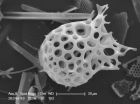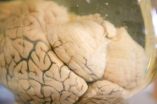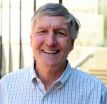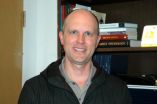(Press-News.org) New genomic research led by UC San Francisco (UCSF) scientists reveals that two common gene variants that lead to longer telomeres, the caps on chromosome ends thought by many scientists to confer health by protecting cells from aging, also significantly increase the risk of developing the deadly brain cancers known as gliomas.
The genetic variants, in two telomere-related genes known as TERT and TERC, are respectively carried by 51 percent and 72 percent of the general population. Because it is somewhat unusual for such risk-conferring variants to be carried by a majority of people, the researchers propose that in these carriers the overall cellular robustness afforded by longer telomeres trumps the increased risk of high-grade gliomas, which are invariably fatal but relatively rare cancers.
The research was published online in Nature Genetics on June 8, 2014.
"There are clearly high barriers to developing gliomas, perhaps because the brain has special protection," said Margaret Wrensch, MPH, PhD, the Stanley D. Lewis and Virginia S. Lewis Endowed Chair in Brain Tumor Research at UCSF and senior author of the new study. "It's not uncommon for people diagnosed with glioma to comment, 'I've never been sick in my life.'"
In a possible example of this genetic balancing act between risks and benefits of telomere length, in one dataset employed in the current study—a massive genomic analysis of telomere length in nearly 40,000 individuals conducted at the University of Leicester in the United Kingdom—shorter telomeres were associated with a significantly increased risk of cardiovascular disease.
"Though longer telomeres might be good for you as a whole person, reducing many health risks and slowing aging, they might also cause some cells to live longer than they're supposed to, which is one of the hallmarks of cancer," said lead author Kyle M. Walsh, PhD, assistant professor of neurological surgery and a member of the Program in Cancer Genetics at UCSF's Helen Diller Family Comprehensive Cancer Center.
In the first phase of the new study, researchers at UCSF and The Mayo Clinic College of Medicine analyzed genome-wide data from 1,644 glioma patients and 7,736 healthy control individuals, including some who took part in The Cancer Genome Atlas project sponsored by the National Cancer Institute and National Human Genome Research Institute. This work confirmed a link between TERT and gliomas that had been made in previous UCSF research, and also identified TERC as a glioma risk factor for the first time.
Since both genes have known roles in regulating the action of telomerase, the enzyme that maintains telomere length, the research team combed the University of Leicester data, and they found that the same TERT and TERC variants associated with glioma risk were also associated with greater telomere length.
UCSF's Elizabeth Blackburn, PhD, shared the 2009 Nobel Prize in Physiology or Medicine for her pioneering work on telomeres and telomerase, an area of research she began in the mid-1970s. In the ensuing decades, untangling the relationships between telomere length and disease has proved to be complex.
In much research, longer telomeres have been considered a sign of health—for example, Blackburn and others have shown that individuals exposed to chronic stressful experiences have shortened telomeres. But because cancer cells promote their own longevity by maintaining telomere length, drug companies have searched for drugs to specifically target and block telomerase in tumors in the hopes that cancer cells will accumulate genetic damage and die.
Walsh said the relevance of the new research should extend beyond gliomas, since TERT variants have also been implicated in lung, prostate, testicular and breast cancers, and TERC variants in leukemia, colon cancer and multiple myeloma. Variants in both TERT and TERC have been found to increase risk of idiopathic pulmonary fibrosis, a progressive disease of the lungs.
In some of these cases, the disease-associated variants promote longer telomeres, and in others shorter telomeres, suggesting that "both longer and shorter telomere length may be pathogenic, depending on the disease under consideration," the authors write.
INFORMATION:
In addition to the Mayo Clinic and Leicester University teams, Wrensch and Walsh were joined by colleagues from University Medical Center Groningen in Germany. Other UCSF authors include Ivan V. Smirnov, PhD; Terri Rice, MPH; Helen M. Hansen; Annette M. Molinaro, PhD; Lucie S. McCoy, MPH; Paige M. Bracci, PhD, MPH; Belinda S. Cabriga; Melike Pekmezci, MD; Shichun Zheng, MD; Joseph L. Wiemels, PhD; Tarik Tihan, MD, PhD; Mitchel S. Berger, MD; Susan M. Chang, MD; Michael D. Prados, MD; and John K. Wiencke, PhD. Alexander R. Pico, PhD, of the Gladstone Institutes also took part in the research, as did members of the ENGAGE Consortium Telomere Group.
Research conducted at UCSF was supported by the National Institutes of Health; the National Brain Tumor Foundation; the UCSF Lewis Chair in Brain Tumor Research; the UCSF Robert Magnin Newman chair in Neuro-Oncology; and by donations from families and friends of John Berardi, Helen Glaser, Elvera Olsen, Raymond E. Cooper and William Martinusen.
UC San Francisco (UCSF), now celebrating the 150th anniversary of its founding, is a leading university dedicated to promoting health worldwide through advanced biomedical research, graduate-level education in the life sciences and health professions, and excellence in patient care. It includes top-ranked graduate schools of dentistry, medicine, nursing and pharmacy, a graduate division with nationally renowned programs in basic, biomedical, translational and population sciences, as well as a preeminent biomedical research enterprise and two top-ranked hospitals, UCSF Medical Center and UCSF Benioff Children's Hospital San Francisco. Please visit http://www.ucsf.edu.
Longer telomeres linked to risk of brain cancer
A double-edged sword, gene variants may promote overall health while increasing risk of gliomas
2014-06-08
ELSE PRESS RELEASES FROM THIS DATE:
New molecule enables quick drug monitoring
2014-06-08
Monitoring the drug concentration in patients is critical for effective treatment, especially in cases of cancer, heart disease, epilepsy and immunosuppression after organ transplants. However, current methods are expensive, time-consuming, and require dedicated personnel and infrastructure away from the patient. Publishing in Nature Chemical Biology, scientists at EPFL introduce novel light-emitting sensor proteins that can quickly and simply show how much drug is in a patient's bloodstream by changing the color of their light. The method is so simple that it could be ...
Retracing early cultivation steps: Lessons from comparing citrus genomes
2014-06-08
Citrus is the world's most widely cultivated fruit crop. In the U.S. alone, the citrus crop was valued at over $3.1 billion in 2013. Originally domesticated in Southeast Asia thousands of years ago before spreading throughout Asia, Europe, and the Americas via trade, citrus is now under attack from citrus greening, an insidious emerging infectious disease that is destroying entire orchards. To help defend citrus against this disease and other threats, researchers worldwide are mobilizing to apply genomic tools and approaches to understand how citrus varieties arose and ...
Warming climates intensify greenhouse gas given out by oceans
2014-06-08
Rising global temperatures could increase the amount of carbon dioxide naturally released by the world's oceans, fuelling further climate change, a study suggests.
Fresh insight into how the oceans can affect CO2 levels in the atmosphere shows that rising temperatures can indirectly increase the amount of the greenhouse gas emitted by the oceans.
Scientists studied a 26,000-year-old sediment core taken from the Gulf of California to find out how the ocean's ability to take up atmospheric CO2 has changed over time.
They tracked the abundance of the key elements silicon ...
Study reveals rats show regret, a cognitive behavior once thought to be uniquely human
2014-06-08
New research from the Department of Neuroscience at the University of Minnesota reveals that rats show regret, a cognitive behavior once thought to be uniquely and fundamentally human.
Research findings were recently published in Nature Neuroscience.
To measure the cognitive behavior of regret, A. David Redish, Ph.D., a professor of neuroscience in the University of Minnesota Department of Neuroscience, and Adam Steiner, a graduate student in the Graduate Program in Neuroscience, who led the study, started from the definitions of regret that economists and psychologists ...
A tiny molecule may help battle depression
2014-06-08
Levels of a small molecule found only in humans and in other primates are lower in the brains of depressed individuals, according to researchers at McGill University and the Douglas Institute. This discovery may hold a key to improving treatment options for those who suffer from depression.
Depression is a common cause of disability, and while viable medications exist to treat it, finding the right medication for individual patients often amounts to trial and error for the physician. In a new study published in the journal Nature Medicine, Dr. Gustavo Turecki, a psychiatrist ...
Targeting tumors using silver nanoparticles
2014-06-08
(Santa Barbara, Calif.) — Scientists at UC Santa Barbara have designed a nanoparticle that has a couple of unique — and important — properties. Spherical in shape and silver in composition, it is encased in a shell coated with a peptide that enables it to target tumor cells. What's more, the shell is etchable so those nanoparticles that don't hit their target can be broken down and eliminated. The research findings appear today in the journal Nature Materials.
The core of the nanoparticle employs a phenomenon called plasmonics. In plasmonics, nanostructured metals such ...
Quick getaway: How flies escape looming predators
2014-06-08
When a fruit fly detects an approaching predator, it takes just a fraction of a second to launch itself into the air and soar gracefully to safety—but there's not always time for that. Some threats demand a quicker getaway, even if things get a little clumsy. New research from scientists at the Howard Hughes Medical Institute's Janelia Research Campus reveals how a quick-escape circuit in the fly's brain overrides the fly's slower, more controlled behavior when a threat becomes urgent.
"The fly's rapid takeoff is, on average, eight milliseconds faster than its more controlled ...
More than just a hill of beans: Phaseolus genome lends insights into nitrogen fixation
2014-06-08
"It doesn't take much to see that the problems of three little people doesn't add up to a hill of beans in this crazy world," Humphrey Bogart famously said in the movie Casablanca. For the farmers and breeders around the world growing the common bean, however, ensuring that there is an abundant supply of this legume is crucial, both for its importance in cropping systems to ensure plant vitality and for food security. Moreover, the U.S. Department of Energy Office of Science has targeted research into the common bean because of its importance in enhancing nitrogen use ...
Argument with dad? Find friendly ears to talk it out, study shows
2014-06-06
With Father's Day approaching, SF State's Jeff Cookston has some advice for creating better harmony with dad. In a recent study, he found that when an adolescent is having an argument with their father and seeks out others for help, the response he or she receives is linked to better well-being and father-child relationships.
Adolescents who receive an reason for the father's behavior or a better understanding of who is at fault feel better about themselves and about dad as well. Those feelings about dad, in turn, are linked to a lower risk of depression for youth.
The ...
Scientists reveal details of calcium 'safety-valve' in cells
2014-06-06
UPTON, NY -- Sometimes a cell has to die-when it's done with its job or inflicted with injury that could otherwise harm an organism. Conversely, cells that refuse to die when expected can lead to cancer. So scientists interested in fighting cancer have been keenly interested in learning the details of "programmed cell death." They want to understand what happens when this process goes awry and identify new targets for anticancer drugs.
The details of one such target have just been identified by a group of scientists from the U.S. Department of Energy's Brookhaven National ...
LAST 30 PRESS RELEASES:
Securing AI systems against growing cybersecurity threats
Longest observation of an active solar region
Why nail-biting, procrastination and other self-sabotaging behaviors are rooted in survival instincts
Regional variations in mechanical properties of porcine leptomeninges
Artificial empathy in therapy and healthcare: advancements in interpersonal interaction technologies
Why some brains switch gears more efficiently than others
UVA’s Jundong Li wins ICDM’S 2025 Tao Li Award for data mining, machine learning
UVA’s low-power, high-performance computer power player Mircea Stan earns National Academy of Inventors fellowship
Not playing by the rules: USU researcher explores filamentous algae dynamics in rivers
Do our body clocks influence our risk of dementia?
Anthropologists offer new evidence of bipedalism in long-debated fossil discovery
Safer receipt paper from wood
Dosage-sensitive genes suggest no whole-genome duplications in ancestral angiosperm
First ancient human herpesvirus genomes document their deep history with humans
Why Some Bacteria Survive Antibiotics and How to Stop Them - New study reveals that bacteria can survive antibiotic treatment through two fundamentally different “shutdown modes”
UCLA study links scar healing to dangerous placenta condition
CHANGE-seq-BE finds off-target changes in the genome from base editors
The Journal of Nuclear Medicine Ahead-of-Print Tip Sheet: January 2, 2026
Delayed or absent first dose of measles, mumps, and rubella vaccination
Trends in US preterm birth rates by household income and race and ethnicity
Study identifies potential biomarker linked to progression and brain inflammation in multiple sclerosis
Many mothers in Norway do not show up for postnatal check-ups
Researchers want to find out why quick clay is so unstable
Superradiant spins show teamwork at the quantum scale
Cleveland Clinic Research links tumor bacteria to immunotherapy resistance in head and neck cancer
First Editorial of 2026: Resisting AI slop
Joint ground- and space-based observations reveal Saturn-mass rogue planet
Inheritable genetic variant offers protection against blood cancer risk and progression
Pigs settled Pacific islands alongside early human voyagers
A Coral reef’s daily pulse reshapes microbes in surrounding waters
[Press-News.org] Longer telomeres linked to risk of brain cancerA double-edged sword, gene variants may promote overall health while increasing risk of gliomas




